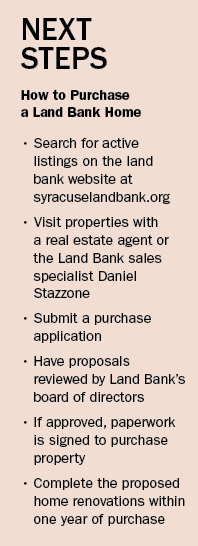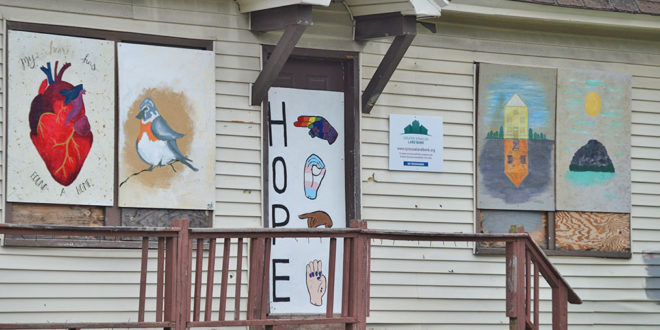The Land Bank explains the steps to follow to complete a purchase
Green and white signs adorn many derelict buildings and vacant lots peppering the South Side, signaling that the properties are owned by the Greater Syracuse Land Bank.
Land Bank officials say they know the signs do not inspire hope and confidence in area residents, and they want to change that negative perception.
The Land Bank owns about 1,080 homes, religious structures, commercial buildings and vacant lots. About 120 of these properties are located on the South Side.
Katelyn Wright, executive director of the Land Bank, says that many community members have misconceptions of the role of the Land Bank and the fate of these properties.
“People assume that we are selling most of our properties to out-of-town landlords or ‘slumlords,’” Wright said. “A lot of people think that those are the kinds of buyers that we are dealing with, but that’s just not the case.”
The Land Bank works to vet potential buyers and encourage owner-occupant purchases.

Shavel Edwards, community engagement specialist at the Land Bank, agrees that what the Land Bank does is not clear to residents. A nonprofit organization, the Land Bank acquires properties through foreclosures, donations and by direct purchase. Land Bank evaluates all properties, assessing them for either repair or demolition.
Necessary repairs and maintenance are addressed to stabilize safety concerns at each property.
Edwards feels that the biggest misconception about the organization is that “the Land Bank is only for investors; that it’s not for the common everyday person that wants to rebuild a house.”
In the last few months, the Land Bank created a new position of community engagement specialist as a way for the organization to better engage with and inform residents in the communities in which they work. Prior to starting this position in August, Edwards worked with many area initiatives, including Mothers Against Gun Violence, for two decades. Her passion for bettering the city she calls home is evident and essential to this role.

“I grew up in Syracuse, and remembering certain neighborhoods and what they used to be,” Edwards said. “You can remember who lived there and how they kept up the home, so just thinking how we can re-envision this for the future, for the next generation.”
“This position was created to hear more of the community’s priorities and concerns and gather feedback from the residents about the Land Bank in the plans and different strategies,” Edwards added.
The Land Bank is one of the larger real estate holders in the city, but the small and committed staff have taken on the task of making the properties affordable and available to those who want to live and invest in Syracuse.
On its website, potential homeowners can view the properties available for purchase, about 85 at the time of publication. The listings are searchable by neighborhood, price, lot size and structure type. Each listing includes a downloadable version of the Land Bank application packet.
The website is a wealth of information and resources for potential homeowners. Staff also host and sponsor educational workshops for new homeowners and financial workshops, some through partnerships with other Syracuse organizations, like Home HeadQuarters.
“We want to make sure that you’ve got all the resources you need to succeed,” Wright said.
Buying a home through the Land Bank is a process, one with steps beyond a traditional mortgage. Purchasers must complete a specific Land Bank application, complete a HUD-approved homebuyer education course for first-time buyers and provide a detailed plan addressing the required renovations and repairs with a timeframe of completion within 12 months of purchase.
Submitting an application is not a guarantee that the potential homeowner will be approved for purchase. Each application packet is presented to the board of directors to be reviewed and approved during monthly meetings, open to the public.
Ayesha Eversley purchased a land bank home in 2015 with her husband after moving from New York City in 2014.
“The process of getting a Land Bank house is not for the faint hearted. You have to know what you’re getting yourself into, and you have to be prepared for it mentally, physically and spiritually,” Eversley said. “(It) turned out to be a lot more than we expected. But in the end it’s worth it.”
Having a larger home and access to a yard was important to her and her growing family. She credits the success of the project to the Land Bank organization for providing support and resources.
Eversley has recruited other family members to purchase Land Bank properties, finding homes on West Kennedy Street, West Beard Avenue and West Borden Avenue in the South Side neighborhood.
“It’s worth it. My mom got a house, my sister has a house … We’re in the process of my aunt getting a house right now. All through the Land Bank,” Eversley said. “I’ve heard a lot of people talk about Land Bank properties, that it’s not good. They don’t know, and they speculate without getting all the correct information. It is a lot of work, and it’s not easy, but to me, it’s worth it.”
— Article by Sarah Tietje-Mietz and Kate Mazade, Staff Reporters
 The Stand
The Stand


